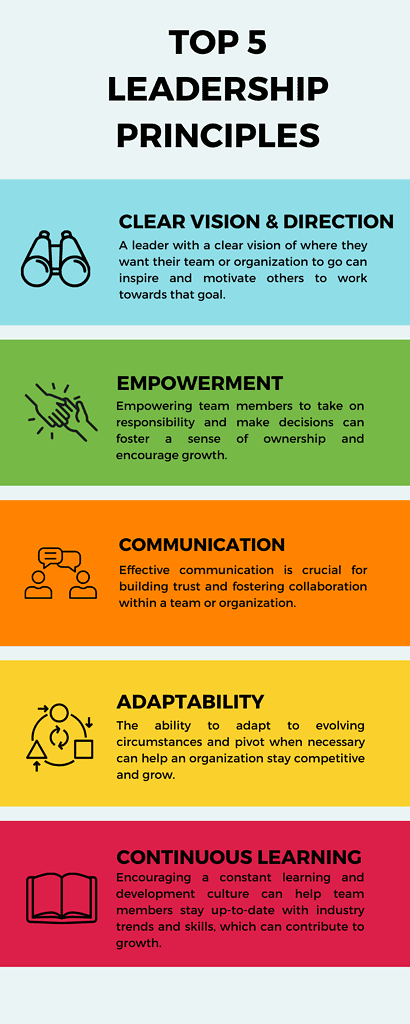
Leadership principles are the foundation of effective leadership. What are the top 5 leadership principles that can lead to growth for a team? Leadership has many facets to it. Great leaders understand that their role is to guide and support their team members, not to micromanage them. They set a clear vision and direction for the team and work to create a shared understanding of the goals and priorities. One of the critical leadership challenges is finding the right balance between being directive and allowing team members the autonomy to make their own decisions. Barry Posner, a leadership expert, said, “The best leaders do the right thing, not the easy thing.”
Successful leaders also recognize that leadership is a continuous learning process and are committed to staying current on best practices and improving their leadership style. They seek feedback from their team members and are open to adjusting their approach as needed. Exceptional leaders also understand that a critical aspect of effective leadership is adapting and responding to change. They are flexible, open-minded, and able to pivot and adjust their strategy as needed.
Great leaders also empower their team members and foster a culture of collaboration and teamwork. They recognize that their team members’ collective expertise and insights can lead to better decision-making and drive innovation and growth. They create an environment where team members feel valued and supported and encourage open communication and idea-sharing. Overall, the best leaders can effectively guide and support their team members while being adaptable and open to new ideas and approaches.
Specifically, through these 5 leadership principles:
- Clear Vision and Direction: A leader with a clear vision of where they want their team or organization to go can inspire and motivate others to work towards that goal.
- Empowerment: Empowering team members to take on responsibility and make decisions can foster a sense of ownership and encourage growth.
- Communication: Effective communication is crucial for building trust and fostering collaboration within a team or organization.
- Adaptability: The ability to adapt to evolving circumstances and pivot when necessary can help an organization stay competitive and grow.
- Continuous Learning: Encouraging a constant learning and development culture can help team members stay up-to-date with industry trends and skills, which can contribute to growth.
Clear Vision and Direction
Clear vision and direction are fundamental leadership principles that inspire and motivate others to work towards a shared goal. A leader with a clear vision of where they want their team or organization to go can communicate that vision in a way that resonates with team members and create a shared understanding of the goals and priorities. This vision can be significant in times of change or uncertainty. A clear vision can provide a sense of direction and purpose.
A clear vision and direction are also essential for setting standards of excellence and fostering a company culture of continuous improvement. Good leaders are always looking for innovative ways to improve and grow, and a clear vision can help guide their efforts and those of their team members. It can also help align the team’s efforts and check everyone is working towards the same goals.
Good leadership involves more than just having a clear vision, however. It also consists of the ability to communicate that vision effectively and to lead by example. Good leaders provide guidance and support to their team members and are willing to offer sound advice and provide opportunities for growth and development. They also set high standards for themselves and strive to be their best version, personally and professionally.

In summary, clear vision and direction are qualities of a great leader. Of the top 5 leadership principles, Leaders who can communicate a clear and compelling vision for their team or organization are better able to inspire and motivate others to work towards that goal and to drive continuous improvement and growth.
Empowerment
Empowerment is a key leadership principle that involves giving team members the authority and resources to take on responsibility and make decisions. This can foster a sense of ownership and encourage growth as team members feel invested in the organization’s success. Empowerment can lead to increased innovation, as team members are encouraged to bring new ideas to the table.
However, empowerment does not mean leaders should abdicate their responsibilities and leave team members to their own devices. Leaders need to provide guidance and support to ensure that team members have the resources they need to succeed. It is also crucial for leaders to communicate expectations clearly and establish clear boundaries.
One key aspect of empowerment is building trust. Leaders who trust their team members and give them the freedom to make decisions are likelier to foster a culture of empowerment. This requires leaders to be open-minded and willing to listen to the perspectives and ideas of team members. Leaders must be transparent and communicate regularly, openly, and honestly.
Empowerment can be challenging and sometimes arduous, especially outside a company’s culture. However, it is worth the effort, as it can lead to increased engagement, productivity, and growth. It is also essential to building a positive company culture, as it demonstrates that leaders value their team members and trust them to contribute to the organization’s success.
One way to begin empowering team members is to take stock of current leadership practices using a leadership practices inventory. This can help leaders identify areas where they can start to shift power and responsibility to team members. Another essential first step is to give team members the time and resources they need to succeed. This may involve providing additional training or support or giving team members the time and space to think and innovate. This is the most reward of the top 5 leadership principles for the team members.
Ultimately, empowerment is about helping team members become the best versions of themselves in their professional and personal lives. It is about building trust, supporting growth, and fostering a sense of responsibility and ownership. When done right, it can be a powerful force for positive change and a kind of human magic that helps organizations and teams to thrive.
Communication
Effective communication is a crucial aspect of good leadership. It is the foundation for building trust and fostering collaboration within a team or organization. Good leaders understand that the best way to communicate is to be clear, transparent, and respectful. They listen to the perspectives of others and share their ideas and expectations in an understandable way for team members. Effective communication is vital for leaders of diverse teams; to bridge barriers and ensure everyone is on the same page.
One example of effective communication is how some airline employees communicate with their passengers. Despite their work’s often hectic and stressful nature, these employees can communicate clearly and calmly with passengers, even in times of crisis. This is especially important given the high stakes and potential risks involved in the airline industry.
Effective communication also involves providing constructive feedback to team members regularly. This can help to improve performance and foster growth. As Barry Posner and James M. Kouzes, authors of “The Practices of Exemplary Leadership,” have said, “Feedback is the breakfast of champions.”
Effective communication is essential not only for team members but for leaders as well. Outstanding leaders can communicate their vision and goals in a way that inspires and propels others. They can also listen to their team members’ perspectives and use feedback to improve their leadership skills. Of the top 5 leadership principles, communication is the tie that binds us.
In summary, effective communication is a powerful tool for leaders. It is the first leadership principle of “The Practices of Exemplary Leadership,” according to James Kouzes. It is the foundation for building trust and fostering collaboration, and it is crucial for the success of any team or organization. The Harvard Business Review has noted, “The longest journey begins with a single step, and the first step of leadership is always communication.”
Adaptability
Adaptability is a crucial leadership principle that involves responding to change and pivoting when necessary. This can help an organization stay competitive and grow, as leaders can adjust their strategy and approach as needed in response to evolving circumstances.
Adaptability is critical in today’s fast-paced business environment, where change is the norm. As Jim Kouzes, a leadership expert, noted, “The world doesn’t stand still, and neither should we.” Good leaders understand that the key to success is anticipating and responding to change.
One way that leaders can foster adaptability is by creating a culture of open communication and transparency. This allows team members to feel comfortable sharing their ideas and perspectives and helps to make a sense of shared ownership and responsibility. Leaders get a clear picture of what is happening on the front lines, which helps to identify opportunities for improvement.
Adaptability is also about being open to new ideas and approaches and willing to take risks and try new things. This can involve embracing new technologies or business models or simply being open to the ideas and perspectives of team members. Poor leaders, on the other hand, are often resistant to change and unwilling to take risks. The top 5 leadership principles that lead to the most breakthroughs is adaptability.
In summary, adaptability is a key quality of a great leader. It involves responding to change, pivoting when necessary, and staying focused on the larger objectives and goals. It also involves being open to new ideas and approaches and willing to take risks and try new things. By fostering adaptability within their team or organization, leaders can help to create a culture of continuous improvement and growth.
Continuous Learning
Encouraging a culture of continuous learning is a critical leadership principle that can contribute to growth. By encouraging team members to stay up-to-date with industry trends and skills, leaders can help their team or organization remain competitive and innovative.
One leadership challenge in continuous learning is striking the right level between short-term and long-term goals. It can be tempting to focus on meeting interim goals and targets, but it is also essential to invest in team members’ long-term development. This may involve setting aside time for training and professional development or encouraging team members to pursue new learning opportunities independently. Of the 5 leadership principles discussed, a shared vision of continuous learning can create a sense of purpose and direction within a team or organization. It helps align the efforts of team members and confirm that everyone is working towards the same goals.
Another important aspect of continuous learning is being open to new ideas and approaches. Outstanding leaders are willing to challenge the status quo and seek new ways of doing things. They are also ready to learn from their mistakes and failures and use them as opportunities for growth and improvement.

The top leaders of my generation are those who are constantly seeking out new learning opportunities. They are willing to take on new challenges and always look for ways to improve their skills and knowledge. This is important in today’s fast-paced business environment, where change is the norm, and it is essential to stay up-to-date.
Overall, continuous learning is at the heart of the business, as it helps to keep teams and organizations innovative and competitive. It is also crucial for human beings on a personal level, as it allows us to grow and develop and to become the best version of ourselves. As Peter Drucker, a management consultant and writer, said, “The only thing constant is change.” By embracing a culture of continuous learning, leaders can help their team or organization to thrive in an ever-changing world.
The 5 leadership principles that work
The five leadership principles that I mentioned (clear vision and direction, empowerment, communication, adaptability, and continuous learning) are important because they are essential for building a solid and effective team or organization.
Clear vision and direction are important because it helps to set a shared understanding of the goals and priorities and provides a sense of direction and purpose. It also helps to align the efforts of team members and ensures that everyone is working towards the same objectives.
Empowerment is crucial because it fosters a sense of ownership and encourages team members to take on responsibility and make decisions. This can propel to an increase in creativity and innovation which can help to drive growth.
Effective communication is needed to build trust and foster collaboration within a team or organization. It is the foundation for building strong relationships and ensuring everyone is on the same page.
Adaptability is essential because it enables an organization to respond to change and pivot when necessary. This can help to keep an organization competitive and innovative.
Continuous learning is important because it helps team members stay up-to-date with industry trends and skills and encourages a culture of continuous improvement. It is also essential for personal and professional growth.
These five leadership principles are essential for building a strong and effective team or organization and driving growth and success.






